| 1 |
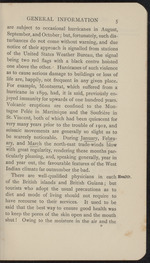 |
“...GENERAL INFORMATION 5
are subject to occasional hurricanes in August,
September, and October; but, fortunately, such dis-
turbances do not come without warning, and due
notice of their approach is signalled from stations
of the United States Weather Bureau, the signal
being two red flags with a black centre hoisted
one above the other. > Hurricanes of such violence
as to cause serious damage to buildings or loss of
life are, happily, nöt frequent in any given place.
For example, Montserrat, which suffered from a
hurricane in 1899, had, it is said, previously en-
joyed immunity for upwards of one hundred years.
Volcanic eruptions are confined to the Mon-
tagne Pelée in Martinique and the Soufrière in
St. Vincent, both of which had been quiescent for
very many years prior to the trouble of 1902, and
seismic movements are generally so slight as to
be scarcely noticeable. During January, Febru-
ary, and March the north-east trade-winds blow
with great regularity, rendering these months par-...”
|
|
| 2 |
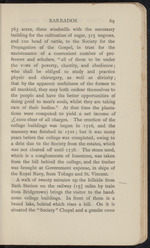 |
“...well as divinity;
that by the apparent usefulness of the former to
all mankind, they may both endear themselves to
the people and have the better opportunities of
doing good to men’s souls, whilst they are taking
care of their bodies.” At that time the planta-
tions were computed to yield a net income of
£2000 clear of all charges. The erection of the
college buildings was begun in 1716, and the
masonry was finished in 1721; but it was many
years before the college was completed, owing to
a debt due to the Society from the estates, which
was not cleared off until 1738. The stone used,
which is a conglomerate of limestone, was taken
from the hill behind the college, and the timber
was brought at Government expense, in ships of
the Royal Navy, from Tobago and St Vincent.
A walk of twenty minutes up the hillside from
Bath Station on the railway (i5§ miles by train
from Bridgetown) brings the visitor to the hand-
some college buildings. In front of them is a
broad lake, behind which rises a hill...”
|
|
| 3 |
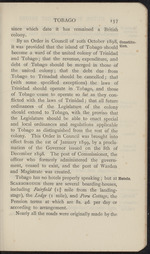 |
“...TOBAGO
J57
since which date it has remained a British
colony.
By an Order in Council of 20th October 1898, constitu-
it was provided that the island of Tobago should tlon-
become a ward of the united colony of Trinidad
and Tobago; that the revenue, expenditure, and
debt of Tobago should be merged in those of
the united colony; that the debt due from
Tobago to Trinadad should be cancelled; that
(with some specified exceptions) the laws of
Trinidad should operate in Tobago, and those
of Tobago cease to operate so far as they con-
flicted with the laws of Trinidad; that all future
ordinances of the Legislature of the colony
should extend to Tobago, with the proviso that
the Legislature should be able to enact special
and local ordinances and regulations applicable
to Tobago as distinguished from the rest of the
colony. This Order in Council was brought into
effect from the 1st of January 1899, by a procla-
mation of the Governor issued on the 8th of
December 1898. The post of Commissioner...”
|
|
| 4 |
 |
“...Cotton and cotton seed. . . 8,280
Live stock....................5,076
Sugar . . . . . . 3,793
Vegetables........................3,545
In the winter months the climate of St. Vincent climate,
is very enjoyable. The wet season lasts from
August to November, when the weather is hot and
damp, though not necessarily unhealthy. The
average rainfall amounts to 100 inches. The
temperature varies from 60° Fahr. to 88° Fahr.,
the nights being always cool. The island is .
sometimes visited by hurricanes, but due notice
of their arrival is always given. Happily the
Soufrière volcano is now quiescent. The death...”
|
|
| 5 |
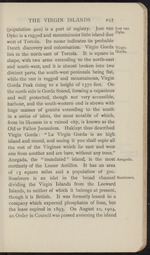 |
“...THE VIRGIN ISLANDS
247
(population 400) is a port of registry. Jost van Jost van
Dyke is a rugged and mountainous little island due Dyke-
west of Tortola. Its name indicates its probable
Dutch discovery and colonisation. Virgin Gorda Virgin
lies to the north-east of Tortola. It is square in Gorda-
shape, with two arms extending to the north-east
and south-west, and it is almost broken into two
distinct parts, the south-west peninsula being flat,
while the rest is rugged and mountainous, Virgin
Gorda Peak rising to a height of 1370 feet. On
the north side is Gorda Sound, forming a capacious
and well protected, though not very accessible,
harbour, and the south-western end is strewn with
huge masses of granite extending to the south
in a series of islets, the most notable of which,
from its likeness to a ruined city, is known as the
Old or Fallen Jerusalem. Hakluyt thus described
Virgin Gorda: “ La Virgin Gorda is an high
island and round, and seeing it you shall espie all
the rest of the...”
|
|
| 6 |
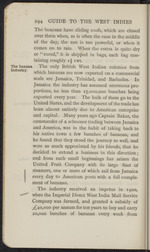 |
“...powerful, or when it
comes on to rain. When the cocoa is quite dry
or “cured,” it is shipped in bags, each bag con-
taining roughly i £ cwt.
The Banana The only British West Indian colonies from
^ which bananas are now exported on a commercial
scale are Jamaica, Trinidad, and Barbados. In
Jamaica the industry has assumed enormous pro-
portions, no less than 15,000,000 bunches being
exported every year. The bulk of them go to the
United States, and the development of the trade has
been almost entirely due to American enterprise
and capital. Many years ago Captain Baker, the
commander of a schooner trading between Jamaica
and America, was in the habit of taking back to
his native town a few bunches of bananas, and
he found that they stood the journey so well, and
were so much appreciated by his friends, that he
decided to extend a business in this direction;
and from such small beginnings has arisen the
United Fruit Company with its large fleet of
1 steamers, one or more of which sail from Jamaica...”
|
|
